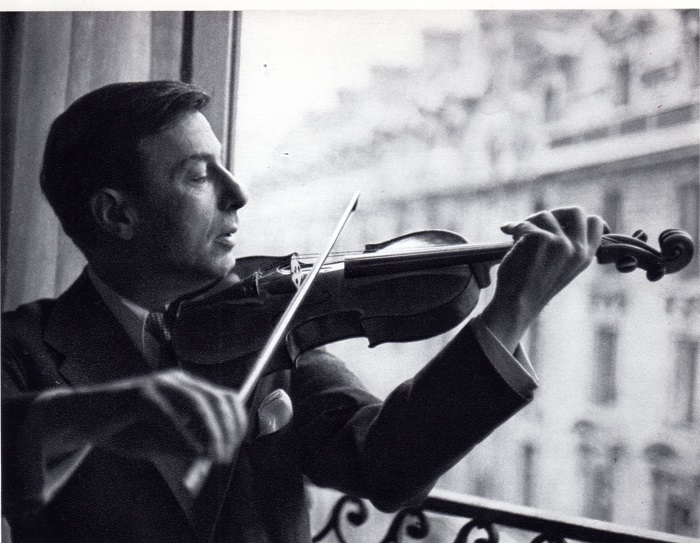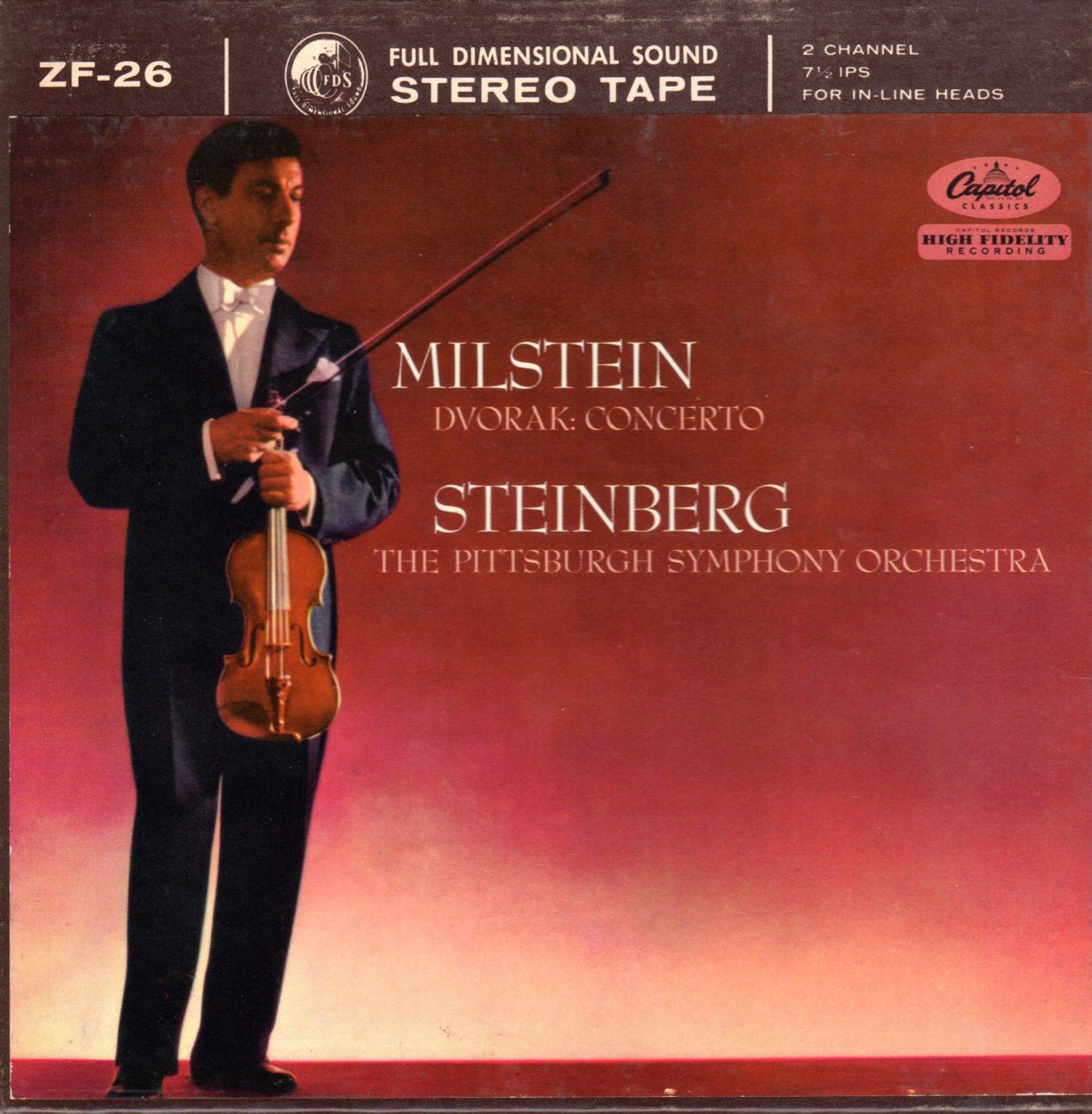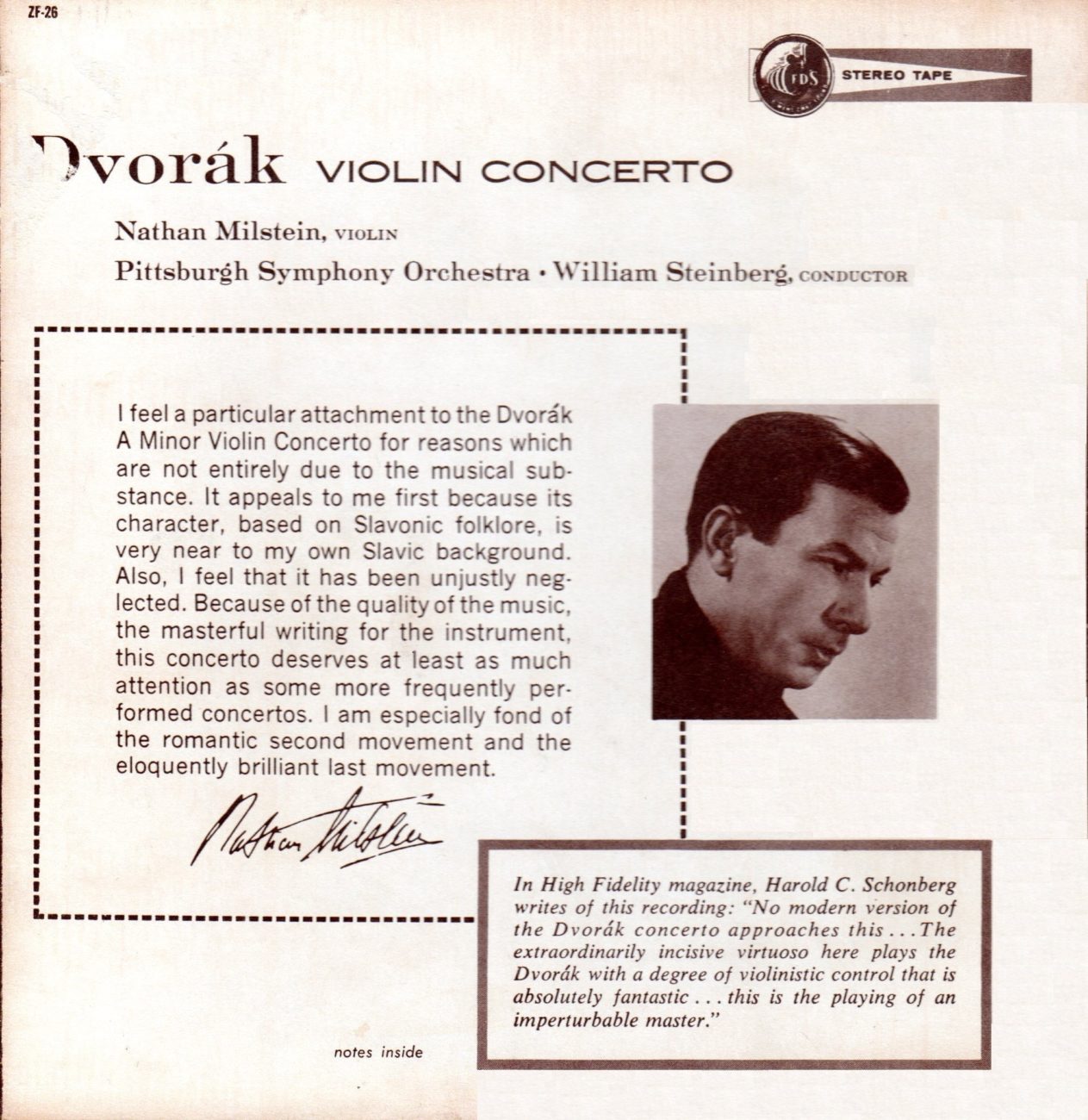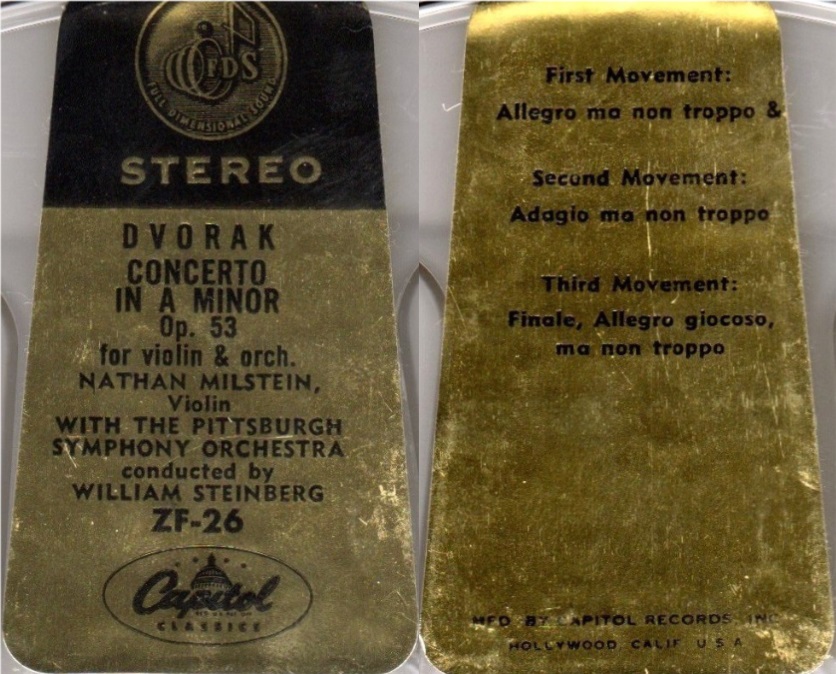
Milstein – Dvořák Concerto Op.53 Steinberg Pittsburgh SO
Dvořák Violin Concerto Op.53
Nathan Milstein
William Steinberg Pittsburgh Symphony Orchestra
Pittsburgh Syria Mosque – April 16 & 17, 1957
Source Bande/Tape Capitol ZF-26: 2 pistes/19 cm/s / 2 tracks 7.5 ips STEREO
C’est en 1930 que Nathan Milstein et William Steinberg (Hans Wilhelm Steinberg) ont joué ensemble pour la première fois. Les enregistrements qu’ils ont faits ensuite (Concertos de Beethoven, Brahms, Bruch, Dvořák, Glazounov, Mendelssohn, et Tchaïkovsky) témoignent de la qualité de leur compréhension réciproque de la musique.
Nathan Milstein jouait ce concerto depuis le début des années trente, et c’était l’un de ses préférés. Dans son livre « From Russia to the West », il parle de certaines de ses premières interprétations de cette œuvre:
‘Gregor Piatigorsky, à l’époque premier violoncelle de l’orchestre de Furtwängler, le Philharmonique de Berlin, nous a présentés. Après mes concerts réussis à Vienne, mon agent Paul Bechert m’a garanti que je jouerais bientôt avec le BPO sous la direction de Furtwängler lui-même. Et c’est ce qui s’est passé : Furtwängler m’a demandé de jouer le Concerto de Dvořák. Je n’aurais jamais pu imaginer que le Dvořák aurait particulièrement intéressé Furtwängler, qui composait lui-même de la musique complexe (et peu attrayante). Mais il s’est avéré qu’il connaissait parfaitement l’œuvre.
Jeune musicien effronté, j’avais l’habitude de faire une coupure dans le mouvement lent du concerto. Furtwängler n’était pas d’accord. Un autre géant de la musique allemande, Richard Strauss, a réagi de la même manière à cette coupure que j’avais faite dans le Dvořák.
Une fois, j’ai dû jouer le concerto à Francfort. Mon agent m’a dit : « Vous allez jouer avec Strauss, j’espère que cela ne vous dérange pas ». Il ne m’est pas venu à l’esprit qu’il parlait du célèbre Richard Strauss, qui était déjà considéré comme un classique à l’époque où je fréquentais l’école de musique d’Odessa, où l’on jouait souvent Mort et Transfiguration et Salomé. En fait, Strauss était plus célèbre dans notre pays que Brahms. Au moment du concert de Francfort, j’étais persuadé qu’il était mort. Je n’ai donc pas prêté attention aux paroles de mon agent concernant le chef d’orchestre qui était prévu – Strauss, Schwartz, quelle différence cela faisait-il?
Lorsque j’ai vu le chef d’orchestre et que j’ai réalisé qu’il s’agissait de Richard Strauss, j’ai été presque choqué. J’étais certain que Strauss ne connaîtrait pas le concerto de Dvořák – comment une telle musique pourrait-elle l’intéresser ? Mais dès le début de la répétition, dès la première minute, je me suis rendu compte qu’il en connaissait chaque note! Et bien sûr, j’ai fait la même coupure dans le mouvement lent, en oubliant de le prévenir. Soudain, il a dit d’un ton de reproche : « Mais c’est la plus belle partie du Concerto« .
Ils l’ont donc dit tous les deux, Strauss et Furtwängler ! Et naturellement, ils avaient raison. Depuis lors, j’ai toujours joué – et enregistré – le Concerto sans coupures!’

Furtwängler Milstein BPO Berlin 25 & 26 Oktober 1931




William Steinberg
It was in 1930 that Nathan Milstein and William Steinberg (Hans Wilhelm Steinberg) performed together for the first time. The recordings that they later made (Concertos by Beethoven, Brahms, Bruch, Dvořák, Glazounov, Mendelssohn,and Tchaïkovsky) bear witness to the quality of their mutual musical understanding.
Nathan Milstein performed this Concerto since the early thirties, and it was one of his favourites. In his book ‘From Russia to the West’, he talks about some of his early perfomances of this work:
‘Gregor Piatigorsky, at the time first cello in Furtwängler’s orchestra, the Berlin Philharmonic, introduced us. After my successful concerts in Vienna, my agent Paul Bechert guaranteed me I will shortly play with the BPO with Furtwängler himself conducting. And so it happened, and Furtwängler asked me to play the Dvořák Concerto. I could not have imagined that the Dvořák would have particularly interested Furtwängler, who composed complex (and not very attractive) music himself. But it turned out he knew the composition note-perfect.
Being a young, brash musician, I used to make a cut in the slow movement of the concerto. Furtwängler did not approve. Another giant of German music, Richard Strauss, reacted the same way to this cut of mine in the Dvořák.
One time, I had to play the Concerto in Frankfurt. My manager told me: ‘You will be performing with Strauss, I hope you don’t mind’. It never occured to me that he was talking about the famous Richard Strauss, who had been considered a classic back when I was at music school in Odessa, where in those years Death and Transfiguration and Salome were often performed. In fact, Strauss was more famous in our country than Brahms. By the time of the concert in Frankfurt, I was sure he had died. So, I paid no attention to the manager’s words about the prospective conductor – Strauss, Schwartz, what difference did it make?
When I saw the maestro and realized that it was the Richard Strauss, I was almost in shock. I was certain that Strauss would not know the Dvořák Concerto – how could music like that interest him? But as soon as the rehearsal began, from the first minute, I realized that he knew it, every note of it! And of course I made the same cut in the slow movement, forgetting to warn him. Suddenly he said reproachfully, ‘But it is the most beautiful part of the Concerto!’
So, they both said it, Strauss and Furtwängler! And naturally, they were right. Since then, I have always played – and recorded – the Concerto without cuts!’
Les liens de téléchargement sont dans le premier commentaire. The download links are in the first comment




6 réponses sur « Milstein – Dvořák Concerto Op.53 Steinberg Pittsburgh SO »
HD / Hi-Res (24 bits/88 KHz):
https://e.pcloud.link/publink/show?code=kZhFpnZ4dfFqpgvzcVAXDWBGW3qz02k1j5X
Format CD / CD Quality (16 bits/44 KHz):
https://e.pcloud.link/publink/show?code=kZjFpnZSNuKLPtlfwmK60NNb0lzP749qeVy
Thanks again for another reel-to-reel treasure!
Excellent post! Another treasure on this amazing web site. Thank You.
Thanks for sharing this. Milstein is a well-known and excellent interpreter of this concerto. However, Josef Suk’s version with the Czech PO and Karel Ancerl still remains my favourite and the most idiomatic interpretation for me.
You are right of course, and we even have two recordings with Suk and Ancerl (studio recording for Supraphon 1960; Salzburger Festspiele 1963)!
Thank you for this upload. It’s a recording I don’t know and I’m looking forward to hearing it.